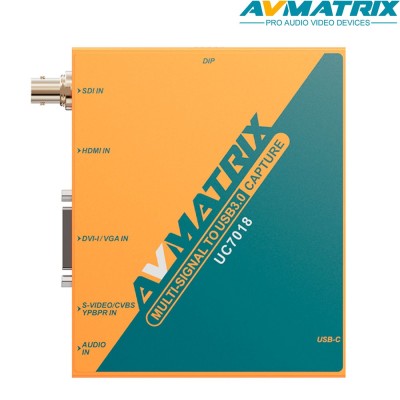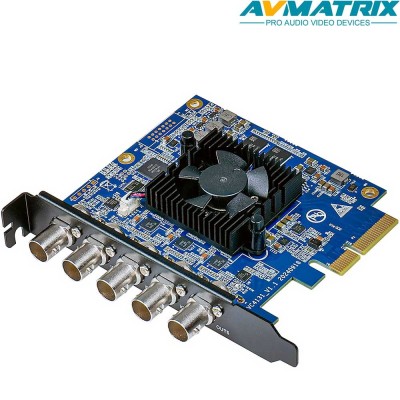Filter By
Brand
Brand
Video Inputs
Video Inputs
Outputs
Outputs
Entradas Audio
Entradas Audio
Salidas Audio
Salidas Audio
Codec / Ficheros
Codec / Ficheros
Protocols
Protocols
Scaler
Scaler
Data and Control
Data and Control
Grabador
Grabador
Comunes
Comunes
Rack Units
Rack Units
Price
Price
-
€117.00 - €7,756.00
Power
Power
Internal Capture Boards
External Capture
Active filters
AVMatrix UC7018 Analog and digital video capture device...
AVMatrix VP51 5-channel SDI Capture and Playback Card
What Are Video Capture Cards?
Video capture cards are devices that allow you to record and stream video and audio signals from an external source (such as a video game console, camera, DVD/VHS player, etc.) to a computer, to then store the content or stream it live. They function as an "input data receiver," taking the signal and sending it to the computer for processing.
Types of Capture Cards by Interface
Internal Capture Cards
These are cards that are installed inside the computer, connecting to one of the motherboard's PCIe slots.
Pros:
- Higher performance and lower latency: Being connected directly to the motherboard, they typically offer better bandwidth and, in some cases, slightly lower latency, which can be crucial for high-quality streaming and recording.
- More stable connection: Since they are fixed inside the PC, the connection is more robust and less prone to accidental disconnections.
- Ideal for dual-PC setups: They allow one computer to be dedicated exclusively to gaming while another handles the capture and streaming, freeing up resources on the gaming PC.
Cons:
- Require a desktop PC: They are not compatible with laptops.
- More complex installation: Opening the PC and installing the card can be intimidating for some users.
- Less versatile: Once installed, they are not easy to move between different computers.
External Capture Cards
These are devices that connect to the computer via a USB port (usually USB 3.0 or higher) or Thunderbolt. They are portable and do not require internal installation.
Pros:
- Easy connection and portability: They simply plug into the computer's USB/Thunderbolt port, making them very versatile and easy to use with different devices (laptops or desktops).
- Ideal for consoles: They are the most common and recommended option for capturing video from video game consoles.
- Simple setup: Most are "plug and play," which makes starting up easier.
Cons:
- May have higher latency: Although many offer very low latency, some may have a minimal delay compared to internal cards, which is rarely an issue for most users.
- Dependence on the USB/Thunderbolt port: The speed and stability of the connection may depend on the quality of the port and cable.
- Can be more expensive for high-end setups.
Common Uses for Capture Cards
Video Game Streaming: Allow gamers to broadcast their gameplay on platforms like Twitch or YouTube with high quality without affecting game performance.
Content Creation: Recording of gameplays, tutorials, reaction videos, and other content for editing and publishing.
Digitization of Older Formats: Some cards can convert analog video signals (VHS, DVD) to digital formats.
Live Production: Using DSLR cameras as high-quality webcams for video calls or live broadcasts.
Recording Conferences and Classes: Capturing presentations and audio for educational or professional purposes.
What Factors Should Be Considered When Choosing the Right Capture Card?
Choosing a video capture card for professional applications is a much more rigorous process than for home or gaming use. The demands for quality, reliability, compatibility, and workflows are significantly higher. Here are the key aspects to consider:
1. Type of Application
Broadcast/TV Production:
Priority: Maximum image quality (uncompressed or with minimal compression), extremely low latency, genlock synchronization, support for professional video formats (SDI, studio HDMI), 24/7 reliability.
Features to look for: SDI inputs/outputs (SD/HD/3G/6G/12G-SDI), time references (Genlock/Tri-Sync), support for professional color space (4:2:2, 4:4:4, 10-bit or 12-bit), compatibility with professional editing and playback software (e.g., DaVinci Resolve, Adobe Premiere Pro, Avid Media Composer), stable and well-supported drivers. Internal PCIe cards are the norm.
Video Editing and Post-Production (film, advertising, documentary):
Priority: Capture and playback in high-quality and high-resolution formats (4K, 8K, RAW), color accuracy, performance, and stability for intensive workflows.
Features to look for: Very high resolutions and frame rates (up to 8K), support for uncompressed video formats or professional codecs (ProRes, DNxHD/HR), advanced color space support, HDMI 2.0/2.1 and/or SDI for professional monitoring, compatibility with non-linear editing software (NLEs).
Live Event Streaming (concerts, conferences, sports):
Priority: Low latency for live interaction, multiple inputs, efficient hardware encoding, reliability for long transmissions.
Features to look for: Multiple inputs (HDMI, SDI), hardware H.264/H.265 encoding (to reduce CPU load), embedded audio support, compatibility with professional streaming software (OBS Studio, vMix, Wirecast), robust portable solutions if used outdoors.
Virtual Production / LED Walls:
Priority: Perfect synchronization between multiple sources (cameras, render engines), minimal latency, high-volume data processing capability.
Features to look for: Multiple SDI inputs, genlock, high bandwidth, ability to process High Dynamic Range (HDR) signals and wide color space.
Medical / Industrial Imaging:
Priority: High resolution, color accuracy, low noise, reliability, and compliance with sector-specific regulations.
Features to look for: Support for specific resolutions of medical/industrial cameras, specialized inputs (e.g., CoaxPress, GigE Vision), reliability in critical environments, compatibility with SDKs for integration into custom software.
2. Professional Connectivity
Unlike home use where HDMI is dominant, in the professional sphere you will find:
SDI (Serial Digital Interface): The industry standard for professional video. Offers long, robust cables, signal locking, and is crucial in broadcast and post-production environments.
Types: HD-SDI, 3G-SDI, 6G-SDI, 12G-SDI (for 4K and above).
HDMI: Although present, it is generally studio HDMI (versions 2.0/2.1 for 4K/8K) with greater robustness and features than consumer versions.
DisplayPort: Less common, but found on some high-end PC cards.
Component/Composite/S-Video: Only for applications digitizing old analog material.
Professional Audio:
AES/EBU: Professional digital audio.
Balanced analog (XLR): For high-quality microphones and audio mixers.
Embedded audio in SDI/HDMI: Most common in professional video, where audio travels with the video signal.
3. Video Formats and Codecs
Uncompressed: Maximum quality, but requires enormous bandwidth and storage. Essential for work where quality is the only thing that matters.
Professional intra-frame codecs: ProRes (Apple), DNxHD/DNxHR (Avid). These are high-quality codecs that retain much of the original information and are ideal for editing.
RAW: For cameras that can send unprocessed sensor data, offering maximum flexibility in post-production. Requires a card compatible with these formats and extremely fast storage.
H.264/H.265 (HEVC): For streaming and final delivery. Some professional cards offer hardware encoding for these codecs, which frees up CPU resources.
4. Resolution and Frame Rate
HD (1080p, 720p): Still relevant for many broadcast and streaming applications.
Ultra HD (UHD 4K): The current standard for high-quality production.
DCI 4K: Slightly higher resolution than UHD 4K, common in cinema.
8K: For very high-end productions, requires extremely powerful cards and systems.
High Frame Rate (HFR): 50p, 60p, 100p, 120p, 240p (for slow motion). Make sure the card supports the desired frame rate in both capture and passthrough.
5. Color Depth and Color Space
8-bit (4:2:0): Common in consumer and web streaming.
10-bit (4:2:2): Professional standard for broadcast and most post-production. Offers greater color fidelity and fewer artifacts.
12-bit (4:4:4): For graphics, compositing, and VFX where maximum color accuracy is crucial.
HDR (High Dynamic Range): Support for HDR10, HLG, Dolby Vision. Crucial for modern productions.
Color Spaces: Rec.709 (HD), Rec.2020 (UHD/4K), DCI-P3.
6. Latency
In professional environments, latency must be minimal (almost imperceptible). This is vital for live monitoring, video mixing, and any real-time interaction.
Internal PCIe cards usually offer the lowest latency.
7. Synchronization (Genlock/Tri-Sync)
Essential in multi-camera and broadcast environments. It allows the video signal from the capture card to be synchronized with other video sources in the studio, avoiding jerks or desynchronization in the final signal. Look for a time reference input (BNC).
8. Drivers and Software Compatibility
Driver Reliability: Drivers must be robust and stable, as a failure can paralyze an entire production.
Compatibility with NLEs and Production Software: Make sure the card is officially compatible with the software you use (DaVinci Resolve, Adobe Premiere Pro, Avid Media Composer, Final Cut Pro, vMix, OBS Studio, etc.). Professional manufacturers typically have extensive compatibility lists.
9. Manufacturer Reliability and Support
Durability: Professional cards are designed for continuous use and demanding environments.
Technical Support: Good post-sales support is crucial in the professional field, with firmware/driver updates and fast technical assistance.
Leading Brands: Blackmagic Design (DeckLink, UltraStudio), AJA (KONA, Io), Magewell. These brands are well known for their quality and reliability in the professional sector.
10. PC System Requirements
High-end Processor: Intel Core i7/i9 or Xeon, or AMD Ryzen 7/9 or Threadripper, with many cores and high frequency.
Plenty of RAM: 32GB, 64GB, or more, depending on the resolution and complexity of the workflow.
Fast Storage: High-speed NVMe SSD for capturing uncompressed video or with high-quality codecs. RAID arrays for large data volumes and sustained performance.
Powerful Graphics Card: Necessary for video processing, effects, rendering, and the user interface of the NLEs.
11. Budget
Professional capture cards are a significant investment, ranging from a few hundred euros/dollars to several thousand. The price reflects the quality of the components, support for advanced features, and reliability.
Buy Video Capture Cards at Avacab Audiovisuales
At Avacab Audiovisuales, we understand that quality and reliability are fundamental pillars for any professional production. That is why we offer a carefully selected range of video capture cards designed to meet the highest demands of the audiovisual industry.
Whether for broadcast, post-production, live events, or virtual reality productions, our solutions guarantee the maximum image fidelity and the lowest possible latency. We work with leading manufacturers in the sector, such as Blackmagic Design, Magewell, Datapath, and AJA, ensuring compatibility with the most advanced workflows.




